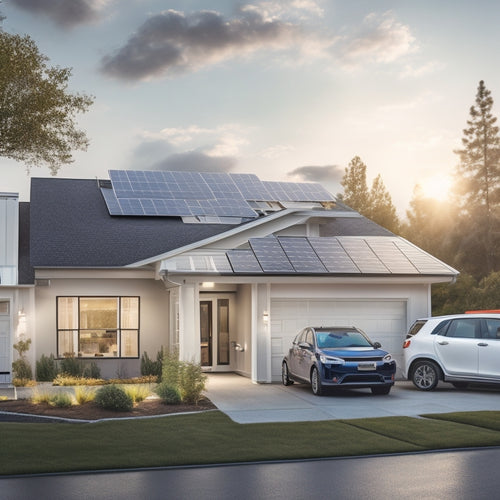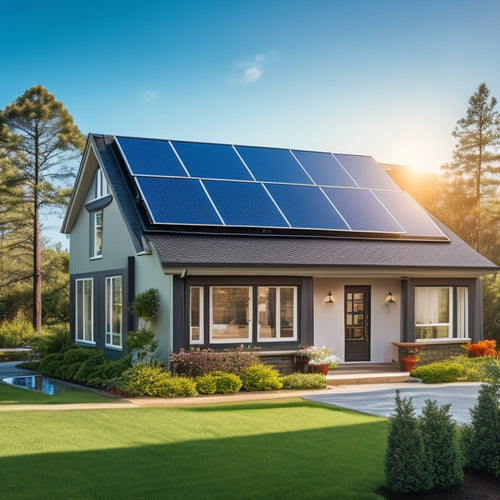
Things to Know Before Installing Floor Mounted Solar Panels
Share
Before installing floor-mounted solar panels, you should understand the types of systems available, including monocrystalline and polycrystalline panels, and the installation options, such as fixed-tilt and tracking systems. You'll need to assess your site's space and layout, considering factors like sunlight exposure, obstacle avoidance, and maintenance accessibility. Additionally, consider your roof's type, condition, and structural integrity, as well as local building codes, permits, and energy efficiency. By accounting for these variables, you'll be better equipped to make informed decisions about your solar panel installation. Now, investigate the details that will take your project to the next level.
Key Takeaways
- Understand the differences between monocrystalline and polycrystalline solar panels to choose the right type for your needs and budget.
- Assess your site's space and layout to determine the optimal solar panel location, configuration, and orientation for maximum energy production.
- Ensure your roof is suitable for solar panels by evaluating its type, condition, pitch, and weight support, and addressing any structural integrity concerns.
- Research and comply with local regulations, building codes, and zoning restrictions to avoid penalties and ensure a successful installation.
- Consider factors like energy efficiency, cost, maintenance, and warranty expectations to make an informed decision about your floor-mounted solar panel system.
Understanding Floor Mounted Systems
With floor-mounted solar panels gaining popularity, it's essential to grasp the fundamental principles of these systems before diving into the installation process.
As you contemplate installing floor-mounted solar panels, you'll need to understand the different types of solar panels suitable for this setup. Monocrystalline and polycrystalline silicon solar panels are common choices, each with their own advantages and disadvantages. Monocrystalline panels offer higher efficiency, while polycrystalline panels are more budget-friendly.
When it comes to installation techniques, you'll need to decide between a fixed-tilt system and a tracking system. Fixed-tilt systems are simpler and more cost-effective, but tracking systems can increase energy production by up to 45%.
You'll also need to contemplate the type of mounting system to use, such as a ballasted or anchored system. Ballasted systems use weights to secure the panels, while anchored systems are attached to the ground using concrete or steel.
Understanding these fundamental principles will help you make informed decisions during the installation process, ensuring a successful and efficient floor-mounted solar panel system.
Space and Layout Considerations
As you prepare to install floor-mounted solar panels, evaluating your available space and designing an ideal layout are crucial steps to guarantee a successful and efficient system.
A thorough site assessment helps identify the best location for your solar panels, considering factors such as sunlight exposure, obstacle avoidance, and accessibility for maintenance. You should assess the size and shape of your available space to determine the best panel configuration.
When designing your layout, consider the direction your panels will face and the angle at which they'll be tilted. This will impact the amount of sunlight they receive and, subsequently, the energy they produce.
Confirm your layout allows for adequate airflow around the panels to prevent overheating, which can reduce their efficiency. Additionally, consider the distance between panels and any nearby structures to prevent shading and enhance energy production.
Roof Type and Condition
When you're planning to install floor-mounted solar panels, you'll need to assess your roof's type and condition to guarantee a safe and successful installation.
You'll want to determine if your roof's material, such as asphalt shingles, metal, or clay tiles, can support the weight of the panels and withstand environmental factors.
Additionally, you'll need to evaluate the roof's age, durability, and structural integrity to identify any potential issues that could affect the installation.
Roof Material Matters
Beyond the obvious consideration of available space, the type and condition of your roof play a crucial role in determining the feasibility of floor-mounted solar panels.
You'll need to assess whether your roof can support the weight and installation requirements of solar panels.
When evaluating your roof, consider the following factors:
-
Roof material: Different solar panel types are compatible with specific roof materials. For instance, some panels are designed for asphalt shingle roofs, while others work better with metal or tile roofs.
-
Roof pitch and angle: The angle and pitch of your roof can affect the installation techniques used and the overall energy output of your solar panels. Steeper roofs may require specialized installation techniques to guarantee secure mounting.
-
Roof obstructions: Consider any obstructions on your roof, such as vents, skylights, or chimneys, which may impact the placement and installation of your solar panels.
Age and Durability
Your roof's age and durability play a significant role in determining whether it can support the installation of floor-mounted solar panels. As you consider installing solar panels, it's crucial to evaluate your roof's condition to guarantee it can withstand the added weight and potential stress of the panels.
A newer roof with a longer lifespan is generally a better candidate for solar panel installation, as it can support the weight of the panels for their entire lifespan, typically 25-30 years.
Older roofs, on the other hand, may require additional reinforcement or even replacement before installing solar panels. Material weathering, such as cracked or damaged shingles, can compromise the structural integrity of your roof, making it unsuitable for solar panel installation.
You should also consider the solar panel lifespan and how it aligns with your roof's expected lifespan. A mismatch between the two could lead to costly repairs or even replacement of the roof or solar panels.
Structural Integrity Check
Evaluating your roof's structural integrity is a critical step in determining its suitability for floor-mounted solar panels. You need to verify your roof can support the weight of the panels, the mounting system, and any additional loads such as snow or wind.
A thorough assessment of your roof's condition and type is essential to avoid any potential risks or damage.
When evaluating your roof's structural integrity, consider the following factors:
-
Roof type: Is your roof made of materials that can support the weight of the solar panels, such as asphalt shingles, metal, or concrete? Or is it made of materials that may not be suitable, like clay tiles or slate?
-
Load distribution: How will the weight of the solar panels be distributed across your roof? Will the load be concentrated in one area, or will it be evenly distributed?
-
Soil stability: Is the soil beneath your foundation stable and able to support the weight of the solar panels and the mounting system?
Local Building Codes and Permits
Local authorities have established building codes and permits to confirm that solar panel installations meet specific standards, and as the installer, it's crucial to comply with these regulations.
You'll need to research and understand the zoning regulations in your area, as they may impact the size and location of your floor-mounted solar panel system.
Before commencing the installation, you'll need to submit permit applications to the relevant authorities, which will trigger an inspection to verify compliance with local ordinances and safety standards.
It's important to familiarize yourself with the compliance guidelines and installation restrictions in your area to avoid any costly rework or penalties.
Environmental considerations, such as the impact on local ecosystems, must also be taken into account.
By adhering to these regulations, you'll not only confirm a safe and efficient installation but also contribute to a sustainable future for your community.
Energy Efficiency and Output
The solar panel system's energy efficiency and output are critical factors in determining its overall performance and your return on investment. You want to guarantee that your floor-mounted solar panels can generate the maximum amount of electricity possible while minimizing energy losses.
To optimize your solar panel system's energy efficiency and output, consider the following key factors:
-
Solar panel efficiency: Look for high-efficiency solar panels with a high power output per unit area. This will enable you to generate more electricity from a smaller surface area.
-
Energy output optimization: Verify that your solar panel system is designed to optimize energy output by considering factors such as panel angle, orientation, and shading.
-
System losses: Minimize system losses by using high-quality components, such as inverters and wiring, that reduce energy losses during transmission and conversion.
Installation and Maintenance Costs
As you've optimized your solar panel system for energy efficiency and output, now it's time to reflect on the financial implications of installing and maintaining your floor-mounted solar panels.
When it comes to installation, you'll want to evaluate the cost of materials, labor, and any necessary permits or inspections. The installation technique you choose can also impact your bottom line, with options like tilt and tracking systems increasing the upfront cost but potentially enhancing energy production.
In terms of maintenance, regular cleaning and inspections can help prevent issues and guarantee your system operates at peak efficiency.
You'll want to factor in the cost of replacement parts and potential repairs, as well as any ongoing maintenance contracts or warranties. By understanding these costs, you can budget accordingly and make informed decisions about your floor-mounted solar panel system.
Be sure to research local incentives and tax credits that can help offset the cost of installation and maintenance.
With the right planning and maintenance tips, you can maximize your return on investment and enjoy the benefits of clean, renewable energy.
Ground Mounted Vs Floor Mounted
When considering solar panel installation, you'll need to decide between ground mounted and floor mounted systems.
This decision will impact your available space and aesthetics, as well as your installation and maintenance costs.
You'll also want to weigh the cost and efficiency of each option to determine which one best fits your needs.
Space and Aesthetics
Several key factors come into play when deciding between ground-mounted and floor-mounted solar panels, and space and aesthetics are two of the most critical elements.
You'll want to evaluate how much space you have available for your solar panel installation, as well as the visual impact it will have on your property.
When it comes to space, floor-mounted solar panels take up more room than their ground-mounted counterparts, since they require a larger footprint to accommodate the mounting system.
On the other hand, ground-mounted systems can be installed on a smaller plot of land, making them ideal for properties with limited space.
In terms of aesthetics, you'll want to reflect on how the solar panels will affect the design elements of your property.
Here are three key factors:
- Visual Impact: How will the solar panels affect the overall look and feel of your property? Will they be noticeable from the street or blend in seamlessly with the surrounding environment?
- Design Elements: Will the solar panels complement or clash with the existing design elements of your property, such as the roofline, siding, or greenery?
- Property Value: Will the solar panels increase or decrease the value of your property, and how will they affect resale value?
Installation and Maintenance
During the planning phase of your solar panel installation, it's vital to take into account the installation and maintenance requirements of both ground-mounted and floor-mounted systems.
You'll want to take into account the installation techniques that work best for your specific setup. For floor-mounted systems, this typically involves anchoring the panels to a concrete slab or a weight-bearing base. Ground-mounted systems, on the other hand, require digging trenches and setting anchor points.
When it comes to maintenance, you'll want to guarantee easy access to the panels for regular cleaning and inspections.
Floor-mounted systems can be more challenging to maintain, as they're often installed at a lower height, making it difficult to clear debris or snow. Ground-mounted systems, being raised, allow for better airflow and easier maintenance.
Additionally, contemplate incorporating maintenance tips into your routine, such as scheduling regular cleaning and monitoring system performance.
Cost and Efficiency
How do you weigh the cost and efficiency of floor-mounted solar panels against their ground-mounted counterparts? When evaluating solar panel financing, it's crucial to assess the initial investment and long-term savings of each option.
Floor-mounted solar panels typically require more materials and labor, increasing upfront costs. However, they can be more efficient with regards to energy production, especially in areas with high energy consumption.
Here are three key factors to take into account in your energy consumption analysis:
-
System size and design: Floor-mounted systems often require more panels to achieve the same energy output as ground-mounted systems, which can increase costs.
-
Installation complexity: Floor-mounted systems may require more complex installation procedures, such as concrete footings and anchoring systems, which can drive up labor costs.
-
Energy output and monitoring: Floor-mounted systems can be more prone to shading and debris accumulation, affecting energy output. Advanced monitoring systems can help optimize energy production and identify potential issues.
Battery Storage and Integration
Typically, a solar panel system's energy output varies throughout the day, often exceeding your immediate energy needs during peak sun hours. This excess energy can be stored in a battery for later use, reducing your reliance on the grid and providing backup power during outages.
When selecting a battery type, consider factors such as depth of discharge, cycle life, and compatibility with your solar inverter. Effective energy management is vital to optimize your system's performance and minimize waste.
Grid integration is also important, as it allows you to feed excess energy back into the grid and offset your energy consumption during periods of low solar production. A scalable system design guarantees that your system can be easily expanded or modified as your energy needs change.
In addition, consider the environmental impact of your battery choice, as some options have a higher carbon footprint than others. By integrating a battery storage system, you can maximize your energy independence and reduce your reliance on fossil fuels.
The installation timeline may be longer due to the added complexity, but the benefits of backup power and reduced energy waste make it a worthwhile investment.
Warranty and Durability Expectations
Warranty and Durability Expectations
Most solar panel systems come with a manufacturer's warranty that covers defects and performance issues for a specific period, usually ranging from 10 to 30 years.
As you consider installing floor-mounted solar panels, it's crucial to understand the warranty types and durability standards that come with your system.
When evaluating warranty options, you should look for the following:
-
Performance warranty: This type of warranty guarantees a minimum energy output from your solar panels over a specified period, usually 25 years or more.
-
Equipment warranty: This warranty covers defects and repairs for individual components, such as inverters, mounting systems, and monitoring systems, typically for 5 to 15 years.
-
Workmanship warranty: This warranty covers labor costs associated with repairing or replacing defective components, usually for 1 to 5 years.
Understanding the warranty and durability expectations of your solar panel system will give you peace of mind and protect your investment for years to come.
Be sure to carefully review the warranty terms and conditions before making a purchase.
Frequently Asked Questions
Can Floor Mounted Solar Panels Be Installed on Uneven Ground?
You'll need to contemplate specialized installation techniques for floor-mounted solar panels on uneven ground, as you'll require ground stabilization measures to guarantee a level surface, which can add complexity and cost to your project.
Are Floor Mounted Solar Panels More Prone to Vandalism?
Curiously, you're not alone in wondering if floor-mounted solar panels are more prone to vandalism. Fortunately, you can take security measures to prevent vandalism, such as installing surveillance cameras, fencing, and alarm systems to guarantee your investment remains safe and secure.
Can I Install Floor Mounted Solar Panels Myself?
You can install floor-mounted solar panels yourself, but you'll need to meet specific installation requirements, like ensuring a stable foundation and proper electrical connections, and consider cost considerations, such as purchasing necessary tools and materials.
Do Floor Mounted Solar Panels Attract Wildlife Nesting?
You'll want to contemplate that floor-mounted solar panels can attract wildlife nesting, as the space underneath provides shelter and protection, potentially altering local wildlife impact and exhibiting nesting behavior, so it's crucial to take preventative measures.
Can Floor Mounted Solar Panels Be Relocated if Needed?
You'll face relocation challenges if you need to move your floor-mounted solar panels, as it'll require reinstallation, potentially incurring additional installation costs, but with careful planning, you can mitigate these expenses and guarantee a seamless relocation process.
Conclusion
Now that you've considered the key factors, you're ready to commence your floor-mounted solar panel adventure. But will you be utilizing the full potential of this renewable energy source? Remember, a well-planned installation is essential to maximize energy output and minimize maintenance costs. By doing your due diligence, you'll be generating clean energy and saving on your utility bills in no time.
Related Posts
-

What Electric Vehicle Owners Need for Home Energy
As an electric vehicle owner, you need to optimize your home energy system to guarantee efficient, sustainable, and c...
-

What You Need to Know About RV Solar Maintenance
When you're out on the road, your RV's solar panel system is your lifeline. But without regular maintenance, you're l...
-

Solar Power Units Perfect for Homes
You're considering installing a solar power unit in your home, a decision that can notably reduce your reliance on tr...


